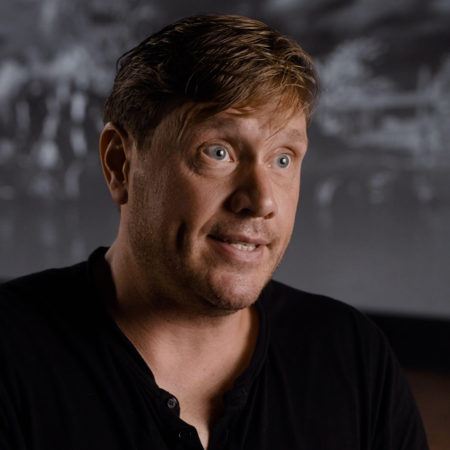Richard Mosse

Richard Mosse was born in 1980 in Kilkenny, Ireland, and currently lives and works in New York City. In 2001 he graduated with a BA from King’s College London and completed his MFA in photography at Yale University in 2008. Mosse’s photographs and films document armed conflicts, humanitarian crises, and environmental crimes, addressing the power and failures of “the documentary image.” His work complicates the production and aesthetics of existing photojournalism and scientific photography, highlighting their insufficiencies and seeking to overcome them. Embarking on multi-year-long projects of repurposing highly specialized film technology and military equipment, Mosse subverts their original intended uses to instead shed light on humanitarian concerns.
The imaging technologies that Mosse employs in his work are produced for specific purposes. They include infrared thermal imaging cameras used to police international borders; multispectral imaging used by both climate scientists and agricultural megacorporations; or Kodak Aerochrome film designed to pick out camouflaged enemy combatants, developed with the United States military during World War II. The aesthetics of his work are in part determined by his equipment and subvert them. It is in how he uses these technologies and what he chooses to document through them that the artist develops a nuanced depiction of catastrophic events. Scale, recognition, and reference all play a part in the visual language built by Mosse to allow viewers a greater insight into these events and processes. In Tristes Tropiques (2022) and Broken Spectre (2022), the artist examines the ecological and humanitarian crisis in the Amazon from three distinct vantage points: flying overhead, at a human scale, and on the forest floor. Each perspective reveals and obfuscates different truths, brought together to paint a fuller picture of what’s occurring in the Amazon while also pointing to the technical and aesthetic mechanisms that abstract the crisis, its impact, and the viewers’ participation in it.
In an earlier project, Incoming (2017), Mosse observes the humanitarian crisis occurring at various borders in Europe, the Middle East, and North Africa. In this body of work, the artist uses a camera equipped with thermal imaging technology typically used in border surveillance. However, Mosse’s photographs and films using the equipment instead paints an unsettling picture of militarized borders and human suffering. The equipment used by the artist is only able to capture in grayscale, creating ghostlike figures and abstracting their images. Incoming demonstrates the dehumanization which occurs at the borders he observes, partly constructed by the technology employed there. At the same time, through the thermal imaging, Mosse is able to capture the transfer of body heat in life-saving efforts, or the sweat of exertion and exhaustion — finding ways to use the equipment to affirm life, rather than deny or endanger it. Across his different projects, the artist works to visualize events, technologies, and systems that often remain unseen, employing the very technologies which obscure, abstract, and enable violence to bring it to the fore.
Videos 1
-
Richard Mosse
“My power, if I have any, is to be able to show you the things that I’ve seen in a more powerful way than perhaps the pictures you’ve seen in the newspaper of the same thing.”
Richard Mosse

